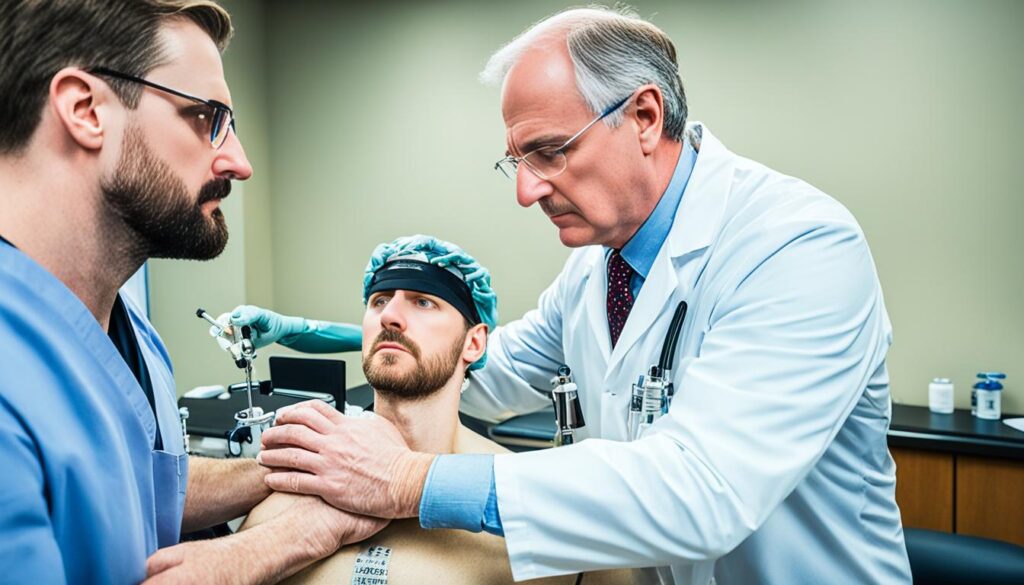In this article, we’ll explore the comprehensive treatment approaches, both surgical and non-surgical, that can provide you with the best chances of regaining function and maximizing your brachial plexus injury recovery.
Table of Contents
ToggleDiagnosis of Brachial Plexus Injuries
Diagnosing a brachial plexus injury involves a thorough evaluation of symptoms and physical examination. Several diagnostic tests may be used to determine the severity and type of injury.
Diagnostic Tests for Brachial Plexus Injuries
- X-ray: This test is performed to check for fractures or associated injuries that may be contributing to the symptoms.
- Electromyography (EMG): EMG evaluates the electrical activity of muscles and can help identify if the brachial plexus is functioning properly.
- Nerve Conduction Studies: Nerve conduction studies assess the speed at which nerve impulses travel through the brachial plexus, providing valuable information about nerve function.
- Magnetic Resonance Imaging (MRI): MRI is a non-invasive imaging technique that can reveal the extent of damage to the brachial plexus and surrounding structures.
- CT Myelography: When MRIs do not provide enough information, CT myelography may be recommended. This procedure involves injecting a contrast dye into the spinal canal to enhance visualization of the brachial plexus.
By utilizing these diagnostic tests, healthcare professionals can accurately diagnose brachial plexus injuries, allowing for appropriate treatment planning and management.
| Diagnostic Test | Purpose |
|---|---|
| X-ray | To check for fractures or associated injuries |
| Electromyography (EMG) | To evaluate the electrical activity of muscles |
| Nerve Conduction Studies | To assess nerve function and conduction speed |
| Magnetic Resonance Imaging (MRI) | To determine the extent of damage |
| CT Myelography | When MRIs do not provide enough information, to enhance visualization of the brachial plexus |

Non-surgical Treatment Options for Brachial Plexus Injuries
When it comes to brachial plexus injuries, non-surgical treatment options can be effective in promoting healing and restoring function. These treatments focus on physical therapy and rehabilitation exercises to help you regain strength, improve range of motion, and manage pain without the need for surgical interventions.
Physical Therapy for Brachial Plexus Injuries
Physical therapy plays a crucial role in the non-surgical treatment of brachial plexus injuries. Under the guidance of a skilled therapist, you will engage in specific exercises and techniques to target the affected limb, improve muscle strength, and enhance overall function. Physical therapy helps maintain range of motion, prevents joint stiffness, and promotes healing in the injured area.
Range of Motion Exercises
Range of motion exercises are an essential part of non-surgical treatment for brachial plexus injuries. These exercises target specific joints and muscles to increase flexibility, prevent stiffness, and improve overall mobility. By performing these exercises regularly, you can regain full range of motion in your shoulder, arm, and hand, allowing you to engage in daily activities with ease.
Pain Management Strategies
Pain management is an important aspect of non-surgical treatment for brachial plexus injuries. Your healthcare team may recommend pain relievers or nerve blocks to alleviate discomfort and improve your overall well-being. These medications can help reduce inflammation, alleviate pain, and enhance your ability to participate in physical therapy and rehabilitation exercises.
Non-surgical treatment options are typically recommended for individuals with mild to moderate brachial plexus injuries. The success of these treatments depends on various factors, including the severity and type of injury, as well as your commitment to following the prescribed treatment plan.
Remember, every brachial plexus injury is unique, and the best course of non-surgical treatment will be determined by a thorough evaluation from your healthcare team. By committing to physical therapy, range of motion exercises, and pain management strategies, you can make significant progress in your recovery and regain function in the affected limb.
With the right non-surgical treatment plan, you can overcome the challenges posed by a brachial plexus injury and get back to living your life to the fullest.
Surgical Treatment Options for Brachial Plexus Injuries
When it comes to treating brachial plexus injuries, surgical interventions can play a critical role in restoring function and improving the overall quality of life. Various surgical treatment options are available, including nerve grafting, nerve transfer, muscle transfer, and neurolysis.
Nerve Grafting: This surgical procedure involves removing the damaged portion of the brachial plexus and replacing it with nerves harvested from other parts of the body. Nerve grafting helps to bridge the gap between healthy and damaged nerves, promoting nerve regeneration and restoring sensation and motor function.
Nerve Transfer: In cases where specific nerves in the brachial plexus are no longer functional, nerve transfer may be a suitable option. This procedure involves attaching a less essential working nerve to a more critical non-working nerve, allowing the transfer of signals and restoring function. Nerve transfer can lead to significant improvements in motor control and muscle strength.
Muscle Transfer: For individuals with severe muscle atrophy or weakness, muscle transfer surgery can be beneficial. This procedure involves relocating a muscle or tendon from another part of the body to the affected limb. The transferred muscle helps compensate for the loss of function and provides improved strength and mobility.
Neurolysis: Neurolysis is a surgical technique used to release the affected nerve from scar tissue or any other constriction that may be impeding its proper function. By removing the constriction, neurolysis helps to restore nerve conduction and improve overall nerve function.

The choice of surgical treatment depends on the specific details of the injury, including its severity and type. A thorough evaluation by a qualified healthcare professional is crucial to determine the most appropriate surgical approach. Surgical treatment options, when combined with postoperative rehabilitation, can offer significant improvements in function and overall quality of life for individuals with brachial plexus injuries.
Pain Management for Brachial Plexus Injuries
Brachial plexus injuries can cause severe pain, significantly impacting your daily life. Effective pain management interventions are crucial in alleviating the discomfort associated with these injuries. Depending on the severity and type of injury, surgical interventions may be recommended to provide pain relief.
In some cases, surgical procedures such as nerve reconstruction or interruption of pain signals can help alleviate the pain caused by brachial plexus injuries. These procedures aim to restore nerve function and reduce pain sensation in the affected area.
Medications are also commonly prescribed to manage brachial plexus injury pain. Pain relievers, including nonsteroidal anti-inflammatory drugs (NSAIDs), can help reduce inflammation and alleviate pain. Your healthcare provider may also prescribe nerve-specific medications, such as anticonvulsants or antidepressants, which can target nerve pain signals directly.
In addition to medications and surgical interventions, pain management techniques can provide additional relief. Physical therapy plays a vital role in managing pain and promoting healing. It can help improve muscle strength, restore range of motion, and reduce pain. Acupuncture, a traditional Chinese medicine practice, may also be beneficial for pain management in some cases. Another technique is transcutaneous electrical nerve stimulation (TENS), which involves using a device to deliver low-voltage electrical currents to the affected area, helping to block pain signals.

An individualized approach to pain management is essential in optimizing your comfort and well-being during the recovery process. Your healthcare team will work closely with you to develop a tailored treatment plan that addresses your specific pain needs and goals.
Recovery and Rehabilitation for Brachial Plexus Injuries
Recovery and rehabilitation are vital components of the comprehensive treatment plan for brachial plexus injuries. A key aspect of this journey is engaging in physical therapy, which aims to restore function and strength to the affected limb. Through carefully designed rehabilitation exercises, individuals with brachial plexus injuries can improve their range of motion, enhance muscle strength, and regain overall mobility.
Physical therapy plays a significant role in the recovery process by helping you regain control and flexibility in your arm, shoulder, and hand. Your physical therapist will work closely with you to create a tailored exercise program that addresses your specific needs and goals.
Rehabilitation exercises will focus on restoring and improving your range of motion, allowing you to regain the ability to perform everyday tasks with ease. These exercises target the affected joints, tendons, and muscles, gradually increasing flexibility and strength over time.
The intensity and duration of rehabilitation programs may vary depending on the severity of your injury and your individual progress. It’s essential to remain dedicated to the prescribed exercises and follow through with consistent practice. Your commitment to the rehabilitation process will greatly contribute to your overall recovery.
Regular follow-up appointments with healthcare professionals, including your physical therapist, are crucial to monitor your progress and make any necessary adjustments to your treatment plan. These appointments will ensure that you receive the support and guidance needed to achieve optimal recovery.
Rehabilitation Exercises for Brachial Plexus Injuries
Here are some common rehabilitation exercises for brachial plexus injuries:
- Passive Range of Motion Exercises: These exercises involve gently moving your affected limb within its range of motion with the help of a therapist or a device.
- Active Range of Motion Exercises: These exercises require you to use your own muscles to move your affected limb through its range of motion.
- Strengthening Exercises: These exercises focus on building strength in the muscles surrounding the brachial plexus, helping you regain power and control in your arm and shoulder.
- Coordination and Balance Exercises: These exercises aim to improve coordination and balance, enhancing your overall functional abilities.
Your physical therapist will guide you through these exercises, ensuring proper form and technique. It’s important to communicate any discomfort or challenges you may experience during these exercises so that your therapist can modify the program accordingly.
Remember, recovery from a brachial plexus injury takes time and dedication. By actively participating in the rehabilitation process and following your healthcare team’s guidance, you can optimize your chances of regaining function and improving your quality of life.

Conclusion
Brachial plexus injuries can have a significant impact on your daily life, causing pain and affecting your arm and hand’s movement and strength. However, there are effective treatment options available to help you recover and regain function in the affected limb.
A comprehensive approach to treatment may include both non-surgical and surgical interventions. Physical therapy and rehabilitation exercises play a crucial role in the recovery process by maintaining range of motion, strengthening muscles, and improving overall function. These exercises are customized to your specific needs and goals, so it’s important to work closely with your healthcare team to develop a personalized treatment plan.
In addition to physical therapy, effective pain management techniques can help alleviate discomfort during the recovery process. Your healthcare team may prescribe pain relievers or recommend other pain management strategies, such as acupuncture or transcutaneous electrical nerve stimulation (TENS), to provide relief.
With proper treatment and support, individuals with brachial plexus injuries can achieve meaningful recovery and improve their overall well-being. Remember to stay committed to your treatment plan and attend regular follow-up appointments to monitor your progress and make any necessary adjustments. By taking proactive steps and working closely with your healthcare team, you can regain function, manage pain, and enhance your quality of life.
FAQ
What are some effective treatment options for brachial plexus injuries?
Effective treatment options for brachial plexus injuries include surgical interventions such as nerve grafting, nerve transfer, and muscle transfer. Non-surgical treatment options focus on physical therapy and rehabilitation exercises.
How are brachial plexus injuries diagnosed?
Brachial plexus injuries are diagnosed through a thorough evaluation of symptoms and physical examination. Diagnostic tests such as X-ray, electromyography (EMG), nerve conduction studies, magnetic resonance imaging (MRI), and CT myelography may be used to determine the severity and type of injury.
What are non-surgical treatment options for brachial plexus injuries?
Non-surgical treatment options for brachial plexus injuries include physical therapy, rehabilitation exercises, and pain management strategies. These treatments help maintain range of motion, strengthen muscles, and alleviate discomfort.
What are surgical treatment options for brachial plexus injuries?
Surgical treatment options for brachial plexus injuries include nerve grafting, nerve transfer, muscle transfer, and neurolysis. These procedures aim to repair damaged nerves, restore function, and alleviate symptoms.
How is pain managed in brachial plexus injuries?
Pain management for brachial plexus injuries may involve surgical procedures, medications such as pain relievers or nerve-specific medications, and techniques like physical therapy, acupuncture, or transcutaneous electrical nerve stimulation (TENS).
What role does recovery and rehabilitation play in brachial plexus injuries?
Recovery and rehabilitation are crucial in the treatment of brachial plexus injuries. Physical therapy and rehabilitation exercises help individuals regain function, strength, and mobility in the affected limb.
How can individuals with brachial plexus injuries improve their overall well-being?
By working closely with their healthcare team, individuals with brachial plexus injuries can develop a personalized treatment plan that includes effective treatment options, such as physical therapy, rehabilitation exercises, and pain management techniques.
Source Links
About The Author

This article is medically reviewed by Dr. Chandril Chugh, Board-Certified Neurologist, providing expert insights and reliable health information.
Dr. Chandril Chugh is a U.S.-trained neurologist with over a decade of experience. Known for his compassionate care, he specializes in treating neurological conditions such as migraines, epilepsy, and Parkinson’s disease. Dr. Chugh is highly regarded for his patient-centered approach and dedication to providing personalized care.
→ Book a consultation to discover which remedies suit your needs best.




